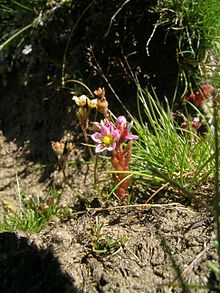Marsh sedum
| Marsh sedum | ||||||||||||
|---|---|---|---|---|---|---|---|---|---|---|---|---|

Marsh sedum ( Sedum villosum ) |
||||||||||||
| Systematics | ||||||||||||
|
||||||||||||
| Scientific name | ||||||||||||
| Sedum villosum | ||||||||||||
| L. |
The Sedum villosum or Hairy sedum ( Sedum villosum ) is a plant from the genus of sedum ( Sedum ) in the family of Crassulaceae (Crassulaceae). It is threatened with extinction in Germany.
features
The marsh sedum plant is a mostly single-growing, evergreen, rosette-free, mostly biennial, rarely also annual or perennial, hemicryptophyte that reaches heights of 5 to 20 centimeters. It is very hairy and glandular and often forms short, sterile side shoots. The leaves are subpulate, half-stemmed, blunt at the tip and 4 to 7 millimeters long. There are 5 pink petals . These are twice as long as the sepals , elliptical, often pointed and pink with a darker central nerve. There are (5 to) 10 stamens .
Flowering time is from June to July. The flowers are pollinated by insects. The seeds are spread by insects or water.
The number of chromosomes is 2n = 30.
Occurrence
The marsh sedum plant occurs in seeping spring meadows, flat moors, ditch edges, as well as nutrient-poor moors and moors. She avoids lime. It thrives on open, oozing or ground-wet, moderately acidic, sandy or pure swamp humus soils or peat soils, also on wet humus sand or stone. It is a pioneer plant. It occurs in societies of the Cardamino-Montion association or in incomplete societies of the Scheuchzerio-Caricetea fuscae class.
The distribution area includes the meridional / submeridional to arctic zone in Europe , Greenland and part of eastern North America. The species is rarely found in Germany in the Alps , in the foothills of the Alps , near Kirchroth / Danube, in the southern Black Forest , on the Hohen Meißner , on the Vogelsberg , in the Rhön and in the Harzgrund near Suhl . It is considered extinct in Lower Saxony, North Rhine-Westphalia, Rhineland-Palatinate, Brandenburg and Saxony. It has fallen sharply or has completely disappeared in numerous areas in Central Europe.
The species, which is considered a pioneer plant, can be promoted through extensive mowing or grazing in connection with soil wounds. This has been practiced for decades at the only known location in Thuringia, for example.
literature
- Eckehart J. Jäger, Klaus Werner (ed.): Rothmaler excursion flora from Germany. Volume 4: Vascular Plants: Critical Volume . Spektrum Akademischer Verlag, Munich 2005, ISBN 3-8274-1496-2 .
- Hans-Joachim Zündorf, Karl-Friedrich Günther, Heiko Korsch and Werner Westhus (eds.): Flora of Thuringia . Weissdorn-Verlag, Jena 2006, ISBN 3-936055-09-2 .
supporting documents
- ↑ a b Erich Oberdorfer : Plant-sociological excursion flora for Germany and neighboring areas . With the collaboration of Angelika Schwabe and Theo Müller. 8th, heavily revised and expanded edition. Eugen Ulmer, Stuttgart (Hohenheim) 2001, ISBN 3-8001-3131-5 , pp. 482 .
- ↑ Jaakko Jalas, Juha Suominen, Raino Lampinen, Arto Kurtto: Atlas florae europaeae . Volume 12 (Resedaceae to Platanaceae). Pages 121-122, Helsinki 1999. ISBN 951-9108-12-2
Web links
- Marsh sedum. In: FloraWeb.de.
- Marsh sedum . In: BiolFlor, the database of biological-ecological characteristics of the flora of Germany.
- Profile and distribution map for Bavaria . In: Botanical Information Hub of Bavaria .
- Sedum villosum L. In: Info Flora , the national data and information center for Swiss flora . Retrieved October 31, 2015.
- Distribution map at Den virtuella floran
- Thomas Meyer: Data sheet with identification key and photos at Flora-de: Flora von Deutschland (old name of the website: Flowers in Swabia )
